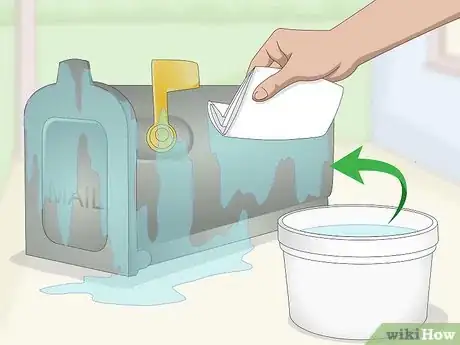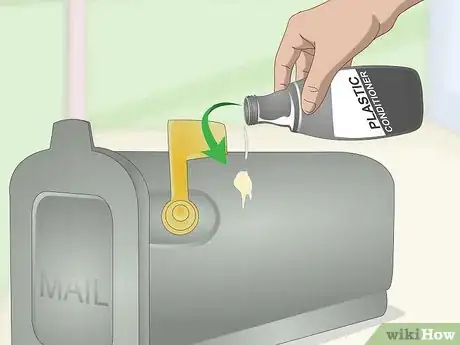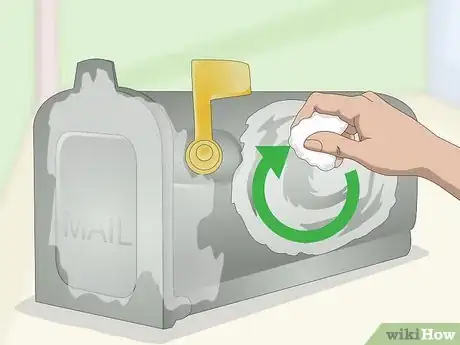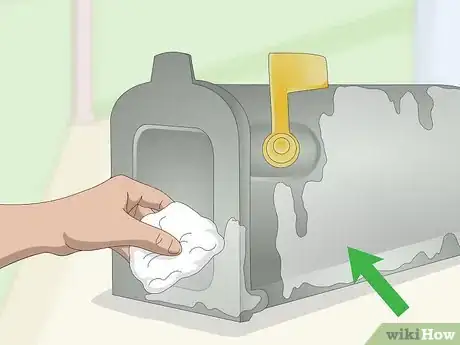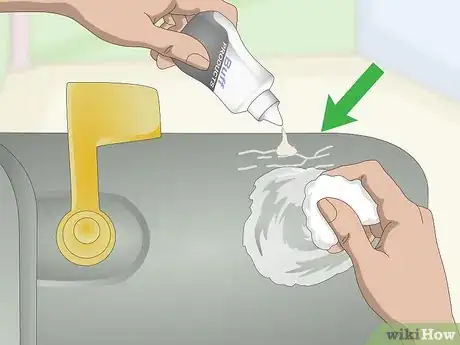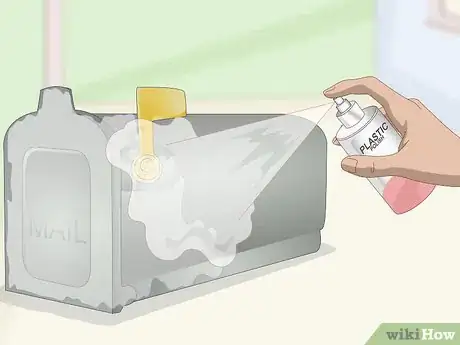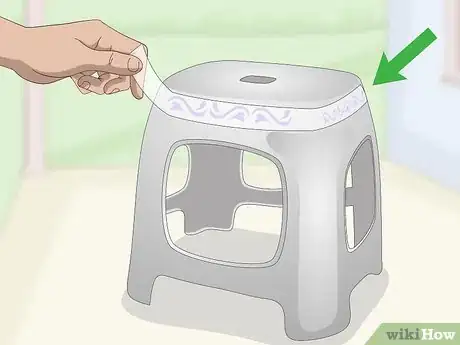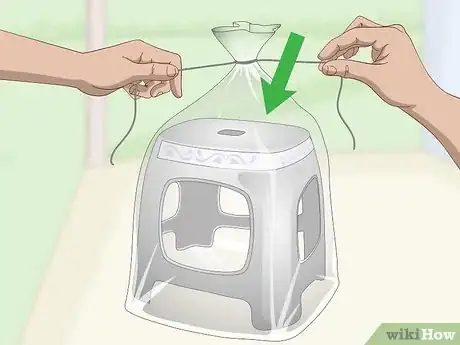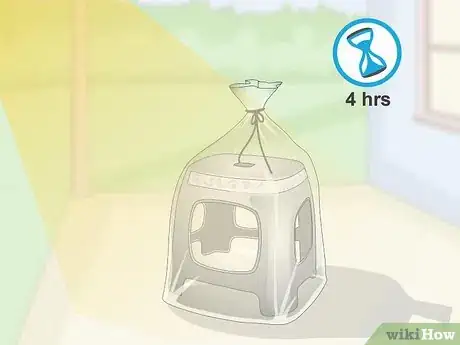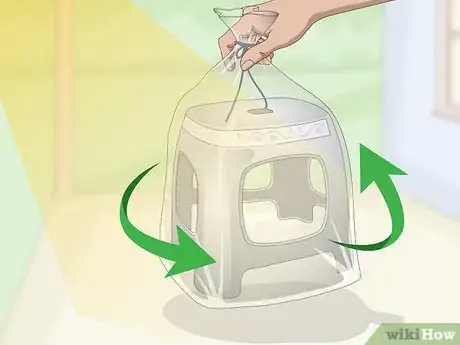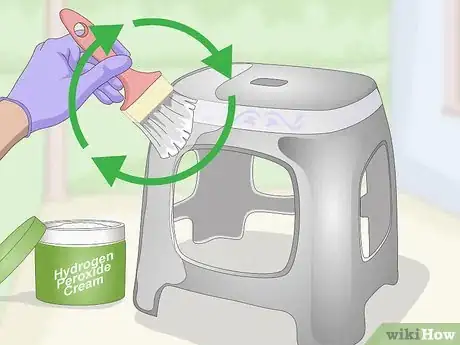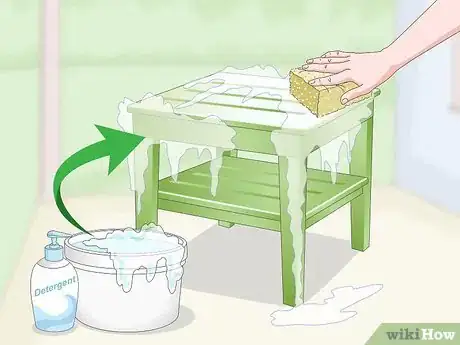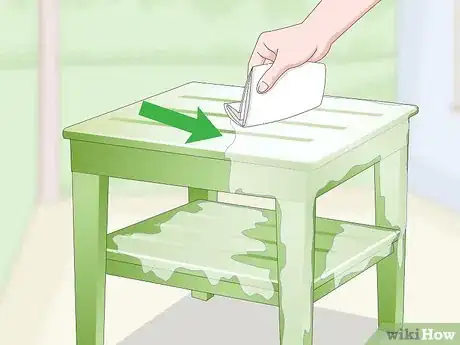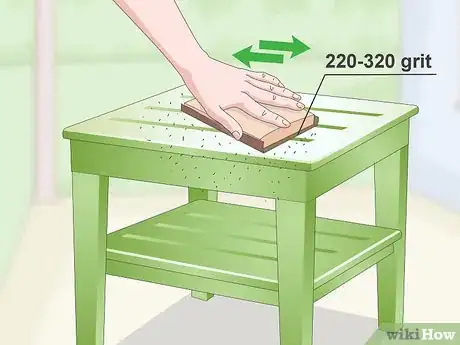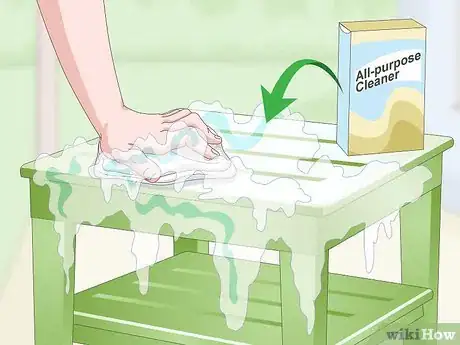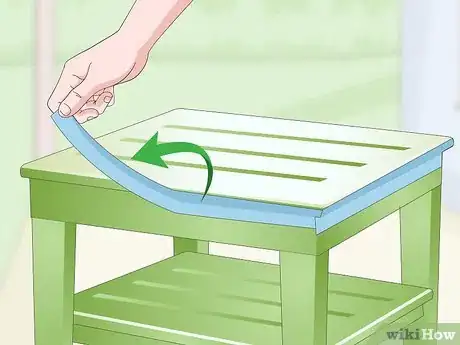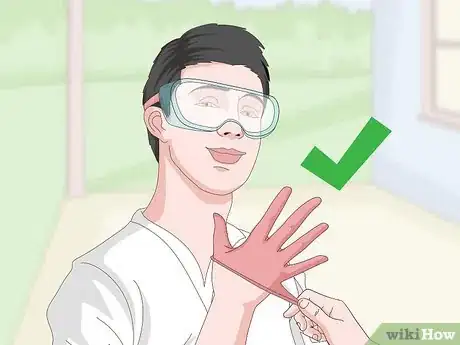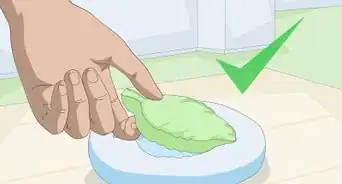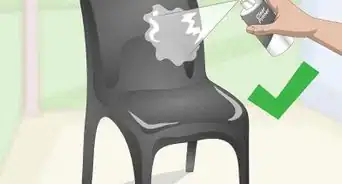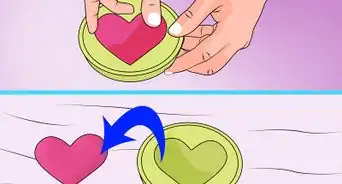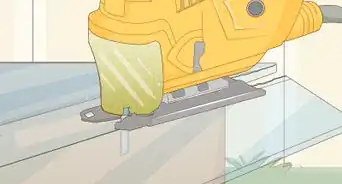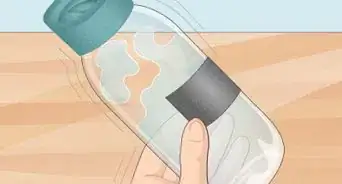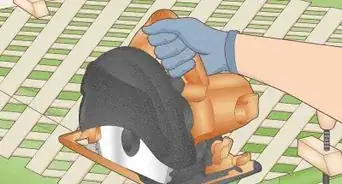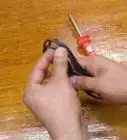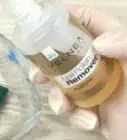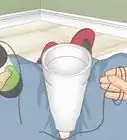This article was co-authored by James Guth. James Guth is the co-owner and founder of Chesapeake Painting Services LLC. With over 20 years of experience, James specializes in exterior and interior painting, drywall, powerwashing, wallpaper, staining, sealing, and carpentry. James holds a BS in Economics and Business Administration with a concentration in Finance from Towson University
This article has been viewed 154,140 times.
Any plastic that comes into contact with the sun will eventually crack and lose coloring. Knowing this, you can preserve valuable items by regularly treating them with commercial plastic conditioning products. If the damage is severe, hydrogen peroxide can reverse the damage, but it should only be used on white or gray products. If all else fails, repainting the plastic is always an option. Take good care of the plastic and you can restore it to look as good as new.
Steps
Using Commercial Restoration Products
-
1Wash and dry the plastic surface. Dampen a microfiber cloth in lukewarm water, then use it to wipe down the plastic. This should remove any dirt, dust, or other debris that can interfere with the cleaning products. Dry the surface fully with a clean microfiber cloth before you apply the conditioner.[1]
- To handle tough stains, clean the plastic with a mixture .5 fl oz (15 mL) of any liquid laundry detergent and 16 fl oz (470 mL) of warm water.
-
2Squeeze plastic conditioner onto the affected area. Purchase a specialized plastic conditioning product. Place a coin-sized drop of conditioner onto the plastic. This should be enough to cover about half of a car's dashboard or any surface smaller than that. Use more conditioner as needed to cover the damaged area completely.
- You can order conditioner online. You may also be able to find it at home improvement or auto parts stores.
- Plastic restoration kits are also available. They usually include conditioner as well as applicator pads.
Advertisement -
3Buff the plastic in a circular motion with a microfiber cloth. Use a clean, soft microfiber cloth. Wipe the cloth in a circular motion until the conditioner is no longer visible on the plastic.
- If you are worried about discoloring the plastic further, test the conditioner in an inconspicuous spot.
-
4Wipe up the excess conditioner after it dries. Most conditioning products dry in 10 minutes or less. If the treatment is working, the conditioner will pass into the plastic, restoring some of the color. Wipe up any conditioner pooled on the plastic after this time.
- Be sure to read the manufacturer’s instructions on the product to check the drying time and any other special instructions.
-
5Apply a second coating if the conditioner is absorbed quickly. Only apply a second coating if the plastic absorbs the conditioner completely within 10 minutes. This means the plastic isn’t fully saturated, so the additional conditioner can help restore it. Avoid adding more conditioner if you noticed excess conditioner pooling on top of the plastic.
- Follow the manufacturer’s instructions for repeated applications. Over time, this may improve the plastic.
- If the conditioner pooled and appeared to have no effect, repeated applications probably will not be enough to restore the plastic.
-
6Use a plastic buffing product if you notice any scratches. Look carefully at the plastic, since sun damage can leave behind unpleasant cracks. Get a buffing product designed for plastic and place a coin-sized amount on a cloth rag. Buff the scratch out using circular motions.[2]
- Buffing products have varying strengths. Some are designed for light scratches while other are effective on deeper cracks.
- Always wipe using circular motions. If you scrub the area, you will wear down the plastic.
-
7Wipe off the buffing product with a microfiber cloth. Go back over the area with a cloth, using it to pick up any product left on the plastic. Remove it all before continuing so the product does not continue to abrade your item.
-
8Spray on a plastic polish. Most polishing products come in a spray bottle, making them easy to apply. Simply move the nozzle across the plastic surface as you spray. Spread a light, even coating over the surface.
- If you get a non-spraying polish, lightly coat a microfiber cloth with the polish.
-
9Rub the polish into the plastic. Use a microfiber cloth to even out the coating and work it into the plastic. For the best results, continue to polish the plastic using circular motions. When you’re finished, the plastic should shine and look much better than when you started.
- If you notice any excess polish pooling over the plastic, simply wipe it off with your cloth.
Bleaching White Plastic with Hydrogen Peroxide
-
1Wear plastic gloves and safety goggles. Hydrogen peroxide can irritate your skin. For your own safety, always wear gloves when handling the cream. Also put on a pair of protective glasses or goggles to shield your eyes.[3]
- Wearing long-sleeved clothing can also help you avoid accidents.
-
2Remove or tape over colored labels and decals. Hydrogen peroxide is only effective for restoring white or gray-colored plastic. Tape off or cover any colored areas you wish to save. You can use a clear office tape or masking tape to protect them.[4]
- If you are able, remove these components before treating the plastic.
- Make sure the tape is flat against the plastic, sealing off the area you wish to protect.
-
3Paint hydrogen peroxide cream over the faded or discolored area. Use a 12% hydrogen peroxide cream instead of the liquid variety most stores carry. Then, brush an even layer of the cream over the area. You can use a paint brush or foam brush. If you don’t have these, an old toothbrush will do.
- Hydrogen peroxide cream is like a gel, so it’s very easy to spread over the discoloration without damaging the rest of the item.
- The cream is used to color hair, so you can often find it in hair coloring kits or purchase it at hair salons.
-
4Seal the item in a plastic bag. If your item is small enough, fit it into a zippered storage bag like the sandwich bags most grocery stores carry. For bigger items, you can use clear garbage bags. Stuff the item in the bag, then zip or tie the opening shut to prevent the cream from drying out.
- The garbage bag has to be clear in order to let in the sunlight, or else the cream will dry without treating the sun damage on the plastic.
- Check to make sure the cream isn’t already drying out. Rinse it off and add more as needed so it doesn’t disfigure the plastic.
-
5Set the bag in direct sunlight for 4 hours. Find a spot to place your item outdoors, if possible. You want to put it under direct sunlight, but not on a hot surface such as asphalt. Although sunlight normally discolors plastic, it can reverse damage as long as your item is coated in hydrogen peroxide cream.[5]
- A table or a stone surface is a great place to stick your item. Make sure it won’t be disturbed there.
-
6Check the bag and rotate it every hour. Return to the plastic item every hour, checking that the cream is still damp. If the bag is sealed, it probably will still be fine. Take the time to turn the item so the sunlight hits the discolored area evenly over the 4 hours.
- The sunlight and shadows may change throughout the day, so keep on your toes.
- Watch for any holes in the bag. If this happens, add more cream before the old layer dries, then move the package into a second bag.
-
7Rinse off the cream before it dries. Dampen a clean rag with lukewarm water. You can use any rag you have available. Wipe off all of the cream, rinsing the rag as needed. Make sure you get all of the cream, since any of it allowed to dry will end up creating some ugly scratches in the plastic.[6]
- Be careful if you’re cleaning off something delicate such as an electronic device. Avoid using too much water. Make sure the rag isn’t dripping wet.
-
8Repeat the cleaning as needed to restore the plastic. You may need to repeat the treatment again before the plastic returns to normal. Add more hydrogen peroxide, bag the item, and set it in the sun again. Always rinse off the cream between treatments.[7]
- When you’re finished, peel off any tape you used. You can then apply a plastic polish if you want to make your plastic shine.
Repainting Plastic with Spray Paint
-
1Wash off the plastic with soap and water. You can use your regular liquid laundry detergent for this. Try mixing about .5 fl oz (15 mL) of detergent in 16 fl oz (470 mL) of hot water. Apply the soap, then rinse it off either with a hose or damp rag.[8]
- Give plastic a thorough washing before attempting to restore it. Plastic restoration products always work better on clean surfaces.
-
2Dry the plastic with a microfiber cloth. Use the cloth to wipe down the plastic. This should remove most of the moisture as well as the dirt and other debris. Make sure the surface is completely dry before continuing.[9]
- You can let the plastic dry in air, but more dust and debris will settle on it the longer you wait.
-
3Sand the area with 220 to 320-grit sandpaper. Be very gentle when using the sandpaper so you don’t scratch the plastic. Rub the sandpaper around the area in a circular motion. When you’re finished, wipe off the debris with a clean microfiber cloth.
- While you can get away with not sanding, roughing up the surface a little helps the paint stick to the plastic.
-
4Apply an all-purpose cleaner to remove stubborn grease. A simple soap and water cleaning can leave on oils that interfere with the paint. For this reason, clean the plastic off a second time with an all-purpose cleaner or degreaser. Rub in the product using a soft microfiber cloth.[10]
- All-purpose cleaners are effective against oils, which can settle on exposed plastics such as cars.
- Another option is rubbing alcohol. Rubbing alcohol is very effective at removing leftover oils.
-
5Place painter’s tape around the discolored area. Paints and dyes will leave you with a different sort of discoloration if they reach areas you don’t want to color. Protect these areas by making a border around the discolored area.
- Painter’s tape is designed for this purpose, but using other varieties, such as masking tape, may also work.
- You can get painter’s tape from most hardware and home improvement stores.
-
6Wear a pair of gloves and a respirator. Unless you want to dye your hands, slip on a pair of gloves before painting. Also, open up any nearby doors and windows if you aren’t working outside. You should wear a respirator mask to avoid breathing in any fumes from the paint or dye.
- Wearing long-sleeved clothes also helps protect your skin. Select old clothing you don’t mind discoloring.
-
7Coat the discolored area with spray paint. Choose a spray paint for plastic that is the color you want. Move the paint can from left to right, applying an even coating as you go.[11] Overlap your strokes until you have covered the entire area.[12]
- For extra effect, apply a layer of primer first. This usually isn’t necessary, but it ensures the paint sticks to the plastic.
- You can also dyes, such as trim dyes for cars. Squeeze a few drops onto the plastic, then spread the dye with a foam brush.
- You can paint the item any color you would like, but you may wish to match the paint to the item’s existing color scheme.
- Always keep your hand moving while you paint—you don't want one spot to get a more concentrated amount of paint.
-
8Let the paint dry for 30 minutes. Give the paint time to dry fully before adding another coating. Depending on your environment, you may need to wait a little longer before the paint is dry to the touch.[13]
-
9Add more layers of paint as needed. You will most likely need to go back and apply a second coating. Repeat the steps, letting the paint dry again. If the paint doesn’t look solid and even, applying multiple layers doesn’t hurt. When you’re finished, allow the paint to dry, remove the tape, and enjoy the new coloring.
- You may also want to apply a paint sealer when you’re finished in order to preserve the paint job longer.
Community Q&A
-
QuestionHow do I restore headlight plastic?
 T. ChinsenTop AnswererOxidation residue is the cause of foggy headlights. Commercially-available kits are available to do the job of restoring headlights. Online results also include the use of glass cleaner, toothpaste, baking soda and vinegar, and are demonstrated on YouTube.
T. ChinsenTop AnswererOxidation residue is the cause of foggy headlights. Commercially-available kits are available to do the job of restoring headlights. Online results also include the use of glass cleaner, toothpaste, baking soda and vinegar, and are demonstrated on YouTube. -
QuestionHow do you clean UV damaged plastic?
 Drew Hawkins1Community AnswerYour best bet is to use some plastic conditioner, which may help reverse any damage caused by UV light. Start by washing the surface with warm water and a microfiber cloth to remove dirt and debris from the surface. If it's really dirty, use a mixture of 5 fl oz (15 mL) of any liquid laundry detergent and 16 fl oz (470 mL) of warm water to clean it. After you wash the plastic, dry it off well with a clean, dry cloth. Use a plastic conditioning product and add about a coin-sized amount to the plastic. Use a clean, soft microfiber cloth. Wipe the cloth in a circular motion until the conditioner is no longer visible on the plastic. Then, wipe off the excess, let it dry, and you should be good to go!
Drew Hawkins1Community AnswerYour best bet is to use some plastic conditioner, which may help reverse any damage caused by UV light. Start by washing the surface with warm water and a microfiber cloth to remove dirt and debris from the surface. If it's really dirty, use a mixture of 5 fl oz (15 mL) of any liquid laundry detergent and 16 fl oz (470 mL) of warm water to clean it. After you wash the plastic, dry it off well with a clean, dry cloth. Use a plastic conditioning product and add about a coin-sized amount to the plastic. Use a clean, soft microfiber cloth. Wipe the cloth in a circular motion until the conditioner is no longer visible on the plastic. Then, wipe off the excess, let it dry, and you should be good to go! -
QuestionCan yellowed plastic be whitened?
 Drew Hawkins1Community AnswerIf you've got white plastic that's faded to yellow, you can actually restore it with hydrogen peroxide! Tape off or cover any colored areas with some clear tape or masking tape so they're protected. Use a 12% hydrogen peroxide cream instead of the liquid and brush an even layer over the area. You can use a paint brush or foam brush. If you don’t have these, an old toothbrush will work just fine. Then, seal the plastic item in a plastic bag or garbage bag to keep the cream from drying out. Find a spot to place your item outdoors, if possible. You want to put it under direct sunlight, but not on a hot surface such as asphalt. Rotate the bag every hour or so until the white color is restored. Rinse off the cream before it dries with a damp rag and you're all set.
Drew Hawkins1Community AnswerIf you've got white plastic that's faded to yellow, you can actually restore it with hydrogen peroxide! Tape off or cover any colored areas with some clear tape or masking tape so they're protected. Use a 12% hydrogen peroxide cream instead of the liquid and brush an even layer over the area. You can use a paint brush or foam brush. If you don’t have these, an old toothbrush will work just fine. Then, seal the plastic item in a plastic bag or garbage bag to keep the cream from drying out. Find a spot to place your item outdoors, if possible. You want to put it under direct sunlight, but not on a hot surface such as asphalt. Rotate the bag every hour or so until the white color is restored. Rinse off the cream before it dries with a damp rag and you're all set.
Warnings
- Always wear protective gear when handling paint and other chemicals.⧼thumbs_response⧽
Things You’ll Need
Using Commercial Restoration Products
- Plastic conditioner
- Plastic buffing product
- Plastic polish
- Microfiber cloths
- Water
Cleaning with Hydrogen Peroxide
- Rubber gloves
- Safety goggles
- Painter’s tape
- Hydrogen peroxide cream
- Foam brush
- Resealable plastic bag
- Clean rag
- Water
Repainting Plastic
- Water
- Liquid laundry detergent
- Microfiber cloth
- 220 to 320-grit sandpaper
- All-purpose cleaner or degreaser
- Painter’s tape
- Rubber gloves
- Respirator mask
- Plastic-safe spray paint or dye
References
- ↑ https://www.autoblog.com/article/how-to-clean-and-restore-plastic-trim-autoblog-details/
- ↑ https://www.bobvila.com/articles/how-to-remove-scratches-from-plastic/
- ↑ http://www.retrofixes.com/2013/10/how-to-clean-whiten-yellowed-plastics.html
- ↑ http://www.retrofixes.com/2013/10/how-to-clean-whiten-yellowed-plastics.html
- ↑ http://www.retrofixes.com/2013/10/how-to-clean-whiten-yellowed-plastics.html
- ↑ http://www.retrofixes.com/2013/10/how-to-clean-whiten-yellowed-plastics.html
- ↑ http://www.retrofixes.com/2013/10/how-to-clean-whiten-yellowed-plastics.html
- ↑ https://www.autoblog.com/article/how-to-clean-and-restore-plastic-trim-autoblog-details/
- ↑ http://www.motoringbox.com/cars/your-car/restoring-black-plastic-trim-permanantly/
About This Article
Before you try to restore sun-damaged plastic, wipe the surface with a damp microfiber cloth to get rid of dirt or any debris. Then, apply a small amount of plastic conditioner, which you can buy online or at a home improvement store. Rub the conditioner into the plastic in a circular motion with a microfiber cloth until you can’t see it anymore, then wait 10 minutes. If there is any conditioner remaining on the surface after the time is up, wipe it off. If the conditioner is absorbed quickly, apply a second coat. Finish by spraying a light coating of plastic polish across the surface. For tips on how to repair white plastic with hydrogen peroxide, read on!
